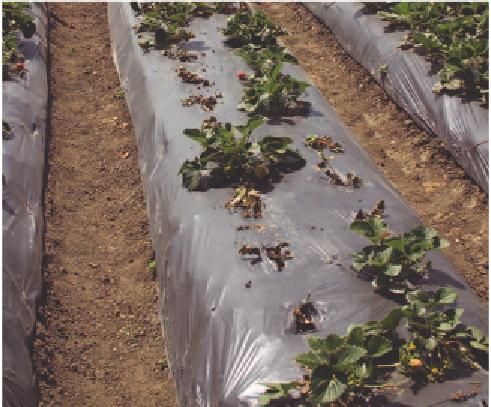Agriculture Reference
In-Depth Information
Management
•
Large, black, irregular resting bodies (sclerotia) form
in this growth.
Plant runners from approved or certifi ed runner schemes.
Plant strawberries only in well-drained soils on raised
beds covered with polythene mulch.
•
Source of infection and spread
The sclerotia enable the fungus to survive in the soil for
long periods. In cool, moist weather, those near the surface
germinate to produce, at soil level, small, cream,
mushroom-like bodies called apothecia. These contain
large numbers of ascospores, which are forcibly discharged
and carried by wind. Before the fungus can attack healthy
fruit, it must first germinate on and infect dying plant
material, such as old petals and leaves. It then invades those
fruit in contact. Cool, wet weather favours infection but
fogs, mists, dews and irrigation provide enough moisture
for infection. Fruit on plants with a dense growth of leaves
are more likely to be affected.
SCLEROTINIA FRUIT ROT
■
Cause
The fungus
Sclerotinia sclerotiorum
.
Symptoms
This disease causes a soft, watery rot of fruit that, in moist
weather, becomes covered with a white fungal growth.
RED STELE ROOT ROT - BIOSECURITY THREAT
Cause
The oomycete
Phytophthora fragariae
var.
fragariae
.
of the root. This reddening is seen when the root is cut
open lengthwise and is more pronounced when plants
are growing in cool soils. The discolouration may
eventually extend to the crown of the plant.
Symptoms
Plants may be stunted and wilt in hot weather. Plants
with less severe root rot may have few or no
aboveground symptoms. Young main roots
progressively rot from the tip to the crown. Lateral roots
often rot and disintegrate. The most characteristic
symptom is a reddish discolouration of the core or stele
Source of infection and spread
The pathogen is spread readily through infected and
often, symptomless planting material. The pathogen
can also be spread by soil movement, drainage water
and contaminated implements. Red stele disease is
associated with wet and cool soils.
Fig 18.31 Dead and stunted strawberry plants caused by an
advanced infection of red stele root rot.
Fig 18.32 Symptoms of red stele root rot seen as black and
desiccated roots.














